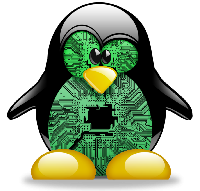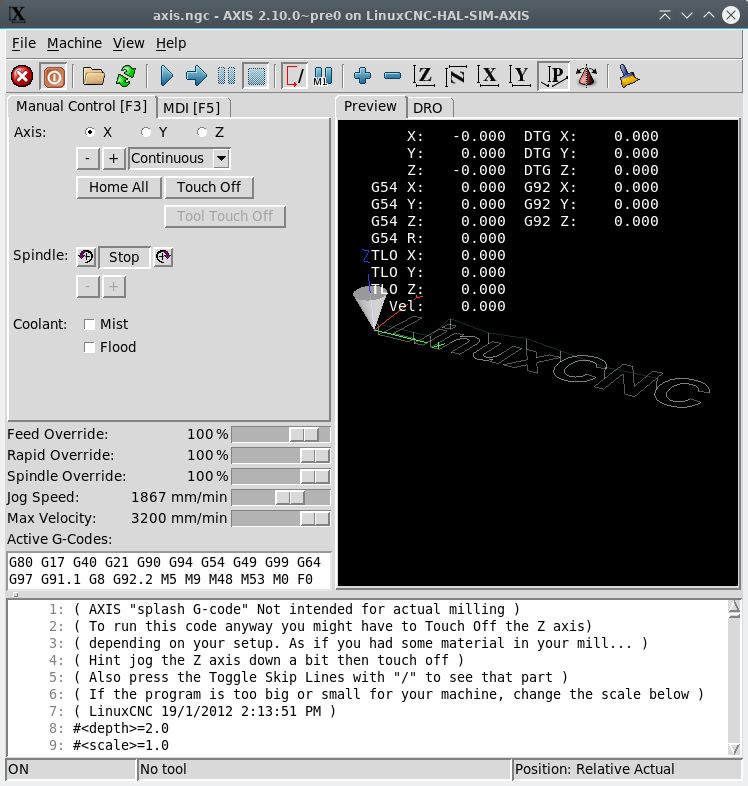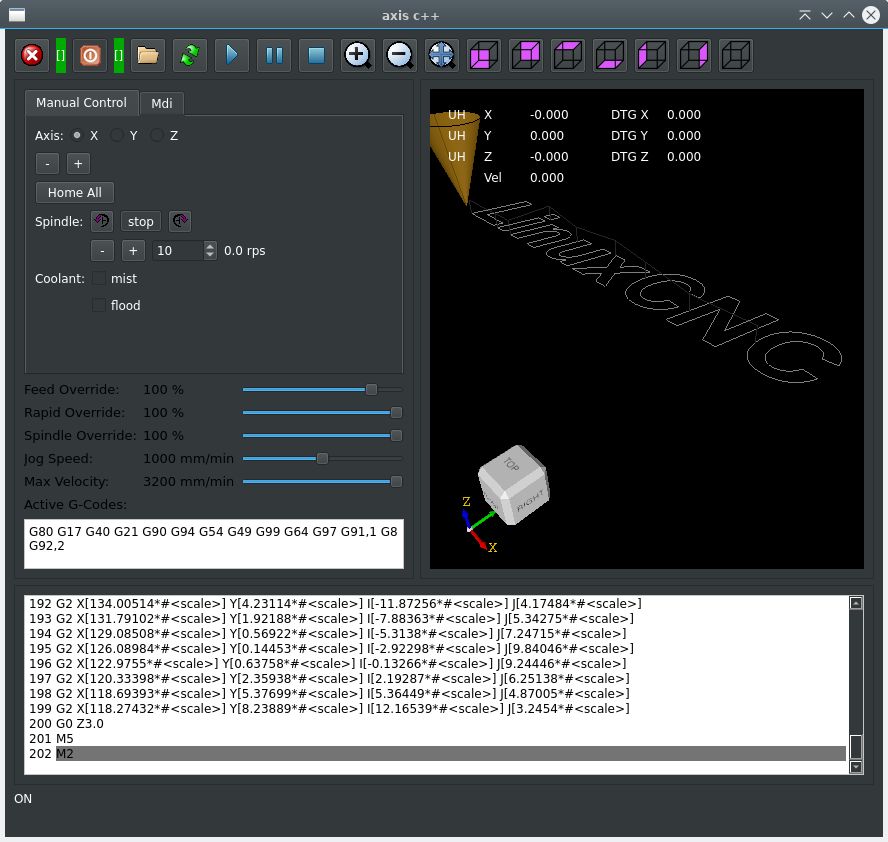linuxcnc c++ axis gui works!
- Grotius
-
 Topic Author
Topic Author
- Offline
- Platinum Member
-

Less
More
- Posts: 2419
- Thank you received: 2344
23 Nov 2023 21:13 #286375
by Grotius
linuxcnc c++ axis gui works! was created by Grotius
Hi,
I made a c++ lcnc controller, that looks a bit like the original axis gui.
This gui is more reactive then any Python coded program interface can be.
Users now can easely modify this gui into any exotic machine program using c++ and
a editor like qt.
It uses a method like the lcnc sai interpreter to load cad data.
It uses the lcnc nml interface.
Original lcnc axis gui:
lcnc axis c++ gui:
Video:
Github:
github.com/grotius-cnc/linuxcnc/tree/mas...s/qt_lcnc_controller
I made a c++ lcnc controller, that looks a bit like the original axis gui.
This gui is more reactive then any Python coded program interface can be.
Users now can easely modify this gui into any exotic machine program using c++ and
a editor like qt.
It uses a method like the lcnc sai interpreter to load cad data.
It uses the lcnc nml interface.
Original lcnc axis gui:
lcnc axis c++ gui:
Video:
Github:
github.com/grotius-cnc/linuxcnc/tree/mas...s/qt_lcnc_controller
Attachments:
The following user(s) said Thank You: opw, tommylight, tivoi, rodw, zz912, Alexandrion, Unlogic
Please Log in or Create an account to join the conversation.
- mungkie
- Offline
- Premium Member
-

Less
More
- Posts: 91
- Thank you received: 5
24 Nov 2023 11:53 - 24 Nov 2023 12:05 #286393
by mungkie
Replied by mungkie on topic linuxcnc c++ axis gui works!
How does the code make preview backplot (3d line segments from gcode) ??
Is there way to reduce resolution so there are fewer line segments in view (reduce memory used)
I cannot see how gcode preview is made in initialize there seems nothing but toolcone/axes/etc..
github.com/grotius-cnc/linuxcnc/blob/mas...opencascade.cpp#L262
How is gcode backplot made and setup?
I think I see in github.com/grotius-cnc/linuxcnc/blob/191.../mainwindow.cpp#L162
it gets data from runInterpreter() and then loops for(uint i=0; i<cadvec.size(); i++) so maybe if I change i++ to i=i+line_reduction it could reduce memory usage?
I will give it a try later but if you have any more usefiul comment to help before I try please comment.
Is there way to reduce resolution so there are fewer line segments in view (reduce memory used)
I cannot see how gcode preview is made in initialize there seems nothing but toolcone/axes/etc..
github.com/grotius-cnc/linuxcnc/blob/mas...opencascade.cpp#L262
How is gcode backplot made and setup?
I think I see in github.com/grotius-cnc/linuxcnc/blob/191.../mainwindow.cpp#L162
it gets data from runInterpreter() and then loops for(uint i=0; i<cadvec.size(); i++) so maybe if I change i++ to i=i+line_reduction it could reduce memory usage?
I will give it a try later but if you have any more usefiul comment to help before I try please comment.
Last edit: 24 Nov 2023 12:05 by mungkie.
Please Log in or Create an account to join the conversation.
- tommylight
-

- Away
- Moderator
-

Less
More
- Posts: 21079
- Thank you received: 7196
24 Nov 2023 13:20 #286400
by tommylight
Replied by tommylight on topic linuxcnc c++ axis gui works!
Search for "gremlin", i think that is the name of the backplot part of LinuxCNC.
The following user(s) said Thank You: Grotius
Please Log in or Create an account to join the conversation.
- Grotius
-
 Topic Author
Topic Author
- Offline
- Platinum Member
-

Less
More
- Posts: 2419
- Thank you received: 2344
24 Nov 2023 15:56 #286409
by Grotius
Replied by Grotius on topic linuxcnc c++ axis gui works!
Hi,
Is there way to reduce resolution so there are fewer line segments in view (reduce memory used)
Yes i can code that. But why do you need it?
How is gcode backplot made and setup?
Its uses the lcnc interpreter to read a gcode file, this spits out gcode data. Then we catch this data and
drop it into opencascade cad viewer. But you can also drop it in opengl, if you have some coded.
This can also show your machine body if coded.
I will give it a try later but if you have any more usefiul comment to help before I try please comment.
Just try to run it, cq1, step by step.
Is there way to reduce resolution so there are fewer line segments in view (reduce memory used)
Yes i can code that. But why do you need it?
How is gcode backplot made and setup?
Its uses the lcnc interpreter to read a gcode file, this spits out gcode data. Then we catch this data and
drop it into opencascade cad viewer. But you can also drop it in opengl, if you have some coded.
This can also show your machine body if coded.
I will give it a try later but if you have any more usefiul comment to help before I try please comment.
Just try to run it, cq1, step by step.
The following user(s) said Thank You: tivoi
Please Log in or Create an account to join the conversation.
- mungkie
- Offline
- Premium Member
-

Less
More
- Posts: 91
- Thank you received: 5
27 Nov 2023 22:45 #286641
by mungkie
Replied by mungkie on topic linuxcnc c++ axis gui works!
Sorry I just realise this use roughly same method as gremlin/axis from the lib/glcannon.py and interprets the gcode with its own method rather than get data from trajectory planner and show simulation of the real paths made by machine.
Please Log in or Create an account to join the conversation.
- vmihalca
- Offline
- Platinum Member
-

Less
More
- Posts: 346
- Thank you received: 22
29 Mar 2024 14:53 #297114
by vmihalca
Replied by vmihalca on topic linuxcnc c++ axis gui works!
There was another linuxcnc UI made in java that I used as an inspiration for my project made in kotlin. I also relied on the external interpreter, but I am not confortable with the fact that I might draw something else than the internal interpreter is doing. While I've worked a bit on the VTK rendering code used by QtPyVcp, I noticed that in the interpreting process it goes from c++ to python then back to c++.
Would it be that hard to decouple this from python so that we could use the internal interpreter as a source of data rather than the external interpreter?
This way we could have UI built in any other language without being so tightly coupled to python.
The guy that worked on the java linuxcnc controller, said that the SAI has has the measurement units hardcoded so that might be buggy.
I don't know linuxcnc into that much depth, but I am convinced that you do. so I was wondering how much of an effort would be to decouple these so that we could use any other programming language that can interact with the NML buffer.
I also had a version that is exposing all the functionality that NML offers through GRPC. That also decouples the linuxcnc from python.
I would really love to push my code as an alternative to python. After almost 20 years of coding object oriented, python makes my eyes bleed.
Would it be that hard to decouple this from python so that we could use the internal interpreter as a source of data rather than the external interpreter?
This way we could have UI built in any other language without being so tightly coupled to python.
The guy that worked on the java linuxcnc controller, said that the SAI has has the measurement units hardcoded so that might be buggy.
I don't know linuxcnc into that much depth, but I am convinced that you do. so I was wondering how much of an effort would be to decouple these so that we could use any other programming language that can interact with the NML buffer.
I also had a version that is exposing all the functionality that NML offers through GRPC. That also decouples the linuxcnc from python.
I would really love to push my code as an alternative to python. After almost 20 years of coding object oriented, python makes my eyes bleed.
The following user(s) said Thank You: langdons
Please Log in or Create an account to join the conversation.
- unknown
- Offline
- Platinum Member
-

Less
More
- Posts: 856
- Thank you received: 297
09 Jun 2025 03:14 - 09 Jun 2025 03:16 #329988
by unknown
Replied by unknown on topic linuxcnc c++ axis gui works!
Ok we get you don't get Python, they are just libraries, not dependencies, the same as you need libs for C & C++ and other things.
WTF you're dragging up a thread that's over 12 months old and repeating your opinions regarding Python & Java & not adding adding that is of relevance, every time you post it has nothing of importance or relevance.
Yeah I get the irony, but (insert vulgar speech here) you're such a (insert vulgar speech here) waste of space.
WTF you're dragging up a thread that's over 12 months old and repeating your opinions regarding Python & Java & not adding adding that is of relevance, every time you post it has nothing of importance or relevance.
Yeah I get the irony, but (insert vulgar speech here) you're such a (insert vulgar speech here) waste of space.
Last edit: 09 Jun 2025 03:16 by unknown.
Please Log in or Create an account to join the conversation.
Time to create page: 0.108 seconds


